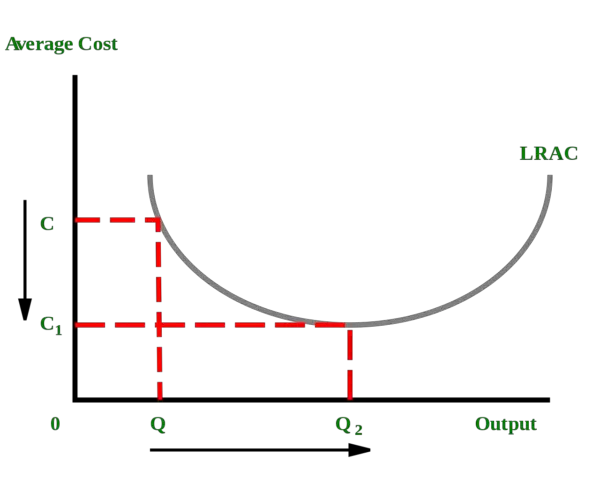Economies and Diseconomies of Scale Explain
AO2 You need to be able to. Ad Browse Discover Thousands of Business Investing Book Titles for Less.

What Is Minimum Efficiency Scale Definition And Explanation Scale Definition Economies Of Scale Basic Concepts
Internal Economies have been conveniently.

. Analyse Apply Comment Demonstrate Distinguish Explain Interpret Sugges. Demonstrate application and analysis of knowledge and understanding Command Terms. There are five 5 types of economies of scale are.
Diseconomies of scale point out the relationship between the average costs of a firm and its total output. When the long run ATC curve rises. Economies of scale refer to the cost advantage experienced by a firm when it increases its level of output.
Purchasing economies Marketing economies Risk bearing economies Technical economies Financial economies. Economies of scale and diseconomies of scale are related concepts and are the exact opposites of one another. Economics questions and answers.
Diseconomies of scale is an economic concept referring to a situation in which economies of scale no longer functions for a firm. Economies of scale arise when the cost per unit reduces as more units are produced and diseconomies of scale arise when the cost per unit increases as more units are produced. The greater the quantity of output produced the lower the per-unit fixed cost.
Internal Economies are those advantages which a firm enjoys from within itself by way of reduction in its average cost of production as its scale of operation expands. Long-run average total cost curve is typically U-shaped. These Internal Economies can be estimated in advance and a firm can set out to secure them by a deliberate policy.
On the other hand diseconomies of scale occur when the average costs of a firm increase due to increased output. With this principle rather than experiencing continued decreasing. Economies and diseconomies of scale explain.
Why the firms short-run marginal cost curve cuts the short-run average variable cost curve at its minimum point. The distinction between fixed and variable costs. Diseconomies of scale occur when a firm experiences an increase in its average costs as its total output increases.
Less flexibility -- harder to change in order to meet consumers wants as quickly as smaller businesses. Dthe distinction between fixed and variable costs. Short-run average fixed cost curve declines so long as output increases.
Diseconomies of scale. The advantage arises due to the inverse relationship between the per-unit fixed cost and the quantity produced. The minimum efficient scale is the point at which the curve first stops falling and levels off.
This can be shown on the diagram below. Economies of scale also result in a fall in. It is able to purchase inputs at a discount which results in lower average cost of.
Any increase in output beyond Q 2 leads to a rise in average costs. The term scale of production refers to the size of a firm. As a firm grows in size it requires larger quantities of production inputs such as raw materials.
Diseconomies of scale occur when. This is the minimum output required by the firm to full exploit economies of scale. Let us discuss the different types of internal economies of scale in detail.
This is an example of diseconomies of scale a rise in average costs due to an increase in the scale of production. Examples of internal diseconomies of scale. This is because in the small-sized firm smaller amount of resources are combined while in a large-sized firms larger amount of resources huge finance and modern technologies are employed to obtain larger output.
The profit-maximizing level of production. Economies and diseconomies of scale explain. Economies and diseconomies of scale AO2 only.
With increase in the order size the firm attains bargaining power over the suppliers. Economies and diseconomies of scale explain why the. Consider the graph shown above.
A small-sized firm yields lower output compared to a large-sized firm. Economies and Diseconomies of scale explain a The profit-maximizing level of production b why the firms long run ATC is U- shaped cWhy the firms short-run marginal cost curve cuts the short sun AVC curve at its min point. Why the firms long-run average total cost curve is U-shaped.
These terms require students to use their knowledge and skills to break down ideas into simpler parts and to see how the parts relate. Economies of Scale is the concept referring to a business event where the price of an item or product decreases as the production of the same item or product increases. Many businesses face challenges when undergoing an expansion as there are increases in workload and clients to serve.
Marginal cost curve must intersect the minimum point of the firms average total cost curve. Economies of scale happens when a business grow large enough to enable them to lower average cost while diseconomies of scale happens when a business grows too large resulting in inefficiency. Examples of external diseconomies of scale.
A purely competitive seller should. Why the firms long run average total cost curve is u-shaped. Economies of Scale vs Diseconomies of Scale.
When a firm doubles its inputs and finds that its output has more than doubled this is known as. Diseconomies of scale usually occur when a firm does no longer experiences economies of.

Economies Of Scale Definition And 8 Examples Boycewire

How To Make Economies Of Scale Work For You Economies Of Scale What Is Economy Economy
What Are Examples Of Diseconomies Of Scale Quora

What Is Minimum Efficiency Scale Definition And Explanation Scale Definition Economies Of Scale Basic Concepts
No comments for "Economies and Diseconomies of Scale Explain"
Post a Comment